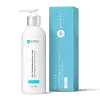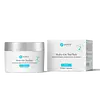What's inside
What's inside
 Key Ingredients
Key Ingredients

 Benefits
Benefits

 Concerns
Concerns

 Ingredients Side-by-side
Ingredients Side-by-side

Water
Skin ConditioningGlycolic Acid 8%
BufferingPropylene Glycol
HumectantAloe Barbadensis Leaf Juice
Skin ConditioningSalicylic Acid 2%
MaskingCetyl Alcohol
EmollientGlyceryl Stearate Se
EmulsifyingCeteareth-20
CleansingCetearyl Alcohol
EmollientGlycine Soja Oil
EmollientStearic Acid
CleansingCarthamus Tinctorius Seed Oil
MaskingEmulsifying Wax Nf
Cucumis Sativus Extract
Skin ConditioningCamellia Sinensis Extract
AntioxidantChamomilla Recutita Flower/Jasminum Officinale Flower Extract
Skin ConditioningAnanas Sativus Fruit Extract
Skin ConditioningCucurbita Pepo Cotyledon Extract
Skin ConditioningCarica Papaya Fruit Extract
Skin ConditioningArctostaphylos Uva-Ursi Leaf Extract
Skin ConditioningGlycyrrhiza Glabra Root Extract
BleachingArginine
MaskingGlutamine
Skin ConditioningPhenoxyethanol
PreservativeEthylhexylglycerin
Skin ConditioningWater, Glycolic Acid 8%, Propylene Glycol, Aloe Barbadensis Leaf Juice, Salicylic Acid 2%, Cetyl Alcohol, Glyceryl Stearate Se, Ceteareth-20, Cetearyl Alcohol, Glycine Soja Oil, Stearic Acid, Carthamus Tinctorius Seed Oil, Emulsifying Wax Nf, Cucumis Sativus Extract, Camellia Sinensis Extract, Chamomilla Recutita Flower/Jasminum Officinale Flower Extract, Ananas Sativus Fruit Extract, Cucurbita Pepo Cotyledon Extract, Carica Papaya Fruit Extract, Arctostaphylos Uva-Ursi Leaf Extract, Glycyrrhiza Glabra Root Extract, Arginine, Glutamine, Phenoxyethanol, Ethylhexylglycerin
Water
Skin ConditioningAlumina
AbrasiveCetearyl Alcohol
EmollientVolcanic Sand
Skin ConditioningIsopropyl Palmitate
EmollientCaprylic/Capric Triglyceride
MaskingCetyl Alcohol
EmollientPropylene Glycol
HumectantGlyceryl Stearate
EmollientCeteareth-20
CleansingEmulsifying Wax Nf
Kaolin
AbrasiveC14-22 Alcohols
Emulsion StabilisingC12-20 Alkyl Glucoside
EmulsifyingGlutathione
Argania Spinosa Kernel Oil
EmollientMelaleuca Alternifolia Leaf Oil
AntioxidantCucumis Sativus Extract
Skin ConditioningCamellia Sinensis Extract
AntioxidantChamomilla Recutita Flower Extract
MaskingSymphytum Officinale Callus Culture Extract
Skin ConditioningAnanas Sativus Fruit Extract
Skin ConditioningCucurbita Pepo Cotyledon Extract
Skin ConditioningCarica Papaya Fruit Extract
Skin ConditioningGlycyrrhiza Glabra Root Extract
BleachingArctostaphylos Uva-Ursi Leaf Extract
Skin ConditioningArbutin
AntioxidantSea Salt
AbrasiveAscorbic Acid
AntioxidantSimmondsia Chinensis Seed Oil
EmollientTocopheryl Acetate
AntioxidantEuterpe Oleracea Fruit Oil
Skin ConditioningPhenoxyethanol
PreservativeEthylhexylglycerin
Skin ConditioningWater, Alumina, Cetearyl Alcohol, Volcanic Sand, Isopropyl Palmitate, Caprylic/Capric Triglyceride, Cetyl Alcohol, Propylene Glycol, Glyceryl Stearate, Ceteareth-20, Emulsifying Wax Nf, Kaolin, C14-22 Alcohols, C12-20 Alkyl Glucoside, Glutathione, Argania Spinosa Kernel Oil, Melaleuca Alternifolia Leaf Oil, Cucumis Sativus Extract, Camellia Sinensis Extract, Chamomilla Recutita Flower Extract, Symphytum Officinale Callus Culture Extract, Ananas Sativus Fruit Extract, Cucurbita Pepo Cotyledon Extract, Carica Papaya Fruit Extract, Glycyrrhiza Glabra Root Extract, Arctostaphylos Uva-Ursi Leaf Extract, Arbutin, Sea Salt, Ascorbic Acid, Simmondsia Chinensis Seed Oil, Tocopheryl Acetate, Euterpe Oleracea Fruit Oil, Phenoxyethanol, Ethylhexylglycerin
Ingredients Explained
These ingredients are found in both products.
Ingredients higher up in an ingredient list are typically present in a larger amount.
Ananas Sativus Fruit Extract comes from the pineapple fruit. Pineapples are native to South America. The components of pineapple give it mild exfoliating and skin nourishing properties.
Pineapples contain Vitamin C, Vitamin B6, copper, potassium, niacin, and other minerals. It also contains many phytochemicals, including ferulic acid, coumaric acid, arbutin, and more. These help condition the skin.
Bromelain can be found in all parts of a pineapple. It is a mixture of enzymes and is mildly exfoliating.
Learn more about Ananas Sativus Fruit ExtractArctostaphylos Uva-Ursi Leaf Extract is from the bearberry plant. It has antioxidant and skin brightening properties.
Bearberry contains arbutin, a skin brightening ingredient.
Camellia Sinensis Extract is from the oil in tea plant leaves. The leaves give us various types of tea: green, black, oolong, and white.
Camellia Sinensis leaves have many benefits. It contains polyphenols, a strong antioxidant. Antioxidants help fight off free-radical molecules that damage skin cells. The antioxidants in green tea neutralize free-radicals from the sun. This gives the skin some extra UV protection, but should not replace sunscreen.
Many components of tea have anti-inflammatory and antimicrobial properties. Polyphenols and L-theanine help soothe the skin and reduce irritation. L-theanine is an amino acid that makes up most of the amino acids found in tea leaves. The caffeine in Camellia Sinensis Leaf Extract helps calm inflamed blood vessels.
Tea leaves also contain Vitamin Bs, linoleic acid, magnesium, calcium, iron, and zinc.
Research has shown both drinking Camellia Sinensis Leaf Tea and applying it to the skin can help boost skin elasticity and hydration. Studies also show using tea extract may reduce sebum, or oil, production.
Learn more about Camellia Sinensis ExtractCarica Papaya Fruit Extract comes from the papaya fruit. Papayas were first domesticated in Mexico and Central America.
This fruit extract contains papain and chymopapain, two types of enzymes. These enzyme have exfoliating and anti-inflammatory properties. One study shows papain may help reduce scarring.
Papaya is also a rich source of antioxidants. Antioxidants protect your skin against damage from free-radical molecules. This may help protect against signs of aging. One antioxidant present in papayas is lycopene.
Papaya also contains Vitamin A, also known as retinol.
While papaya is used as an ingredient to help lighten skin, research is limited on this.
The seeds of papaya have been found to have anti-fungal activity.
Learn more about Carica Papaya Fruit ExtractCeteareth-20 is an emulsifier and cleansing agent. It is derived from cetearyl alcohol, a fatty alcohol.
As an emulsifier, Ceteareth-20 prevents oil and water from separating. It is also a surfactant. Surfactants help gather oil, pollution, and dirt to be washed away.
Cetearyl alcohol is a mixture of two fatty alcohols: cetyl alcohol and stearyl alcohol. It is mainly used as an emulsifier. Emulsifiers help prevent the separation of oils and products. Due to its composition, it can also be used to thicken a product or help create foam.
Cetearyl alcohol is an emollient. Emollients help soothe and hydrate the skin by trapping moisture.
Studies show Cetearyl alcohol is non-toxic and non-irritating. The FDA allows products labeled "alcohol-free" to have fatty alcohols.
This ingredient is usually derived from plant oils such as palm, vegetable, or coconut oils. There is debate on whether this ingredient will cause acne.
Due to the fatty acid base, this ingredient may not be Malassezia folliculitis safe.
Learn more about Cetearyl AlcoholCetyl Alcohol is a fatty alcohol. Fatty Alcohols are most often used as an emollient or to thicken a product.
Its main roles are:
Though it has "alcohol" in the name, it is not related to denatured alcohol or ethyl alcohol.
The FDA allows products labeled "alcohol-free" to have fatty alcohols.
Learn more about Cetyl AlcoholCucumis Sativus Extract comes from the cucumber. Cucumbers have anti-aging, anti-inflammatory, and hydrating properties.
Cucumbers are mostly made up of water (95%), and the other 5% is composed of: vitamin C, caffeic acid, fatty acids, amino acids, and other minerals.
We don't have a description for Cucurbita Pepo Cotyledon Extract yet.
Ethylhexylglycerin (we can't pronounce this either) is commonly used as a preservative and skin softener. It is derived from glyceryl.
You might see Ethylhexylglycerin often paired with other preservatives such as phenoxyethanol. Ethylhexylglycerin has been found to increase the effectiveness of these other preservatives.
Glycyrrhiza Glabra Root Extract is an extract of the roots of Licorice. It has been found to have several benefits such as skin hydrating, conditioning, and soothing.
One component, glabridin, has extra potent antioxidant and soothing properties. It has also been found to block pigmentation from UVB rays in guinea pigs.
Licorice Root also contains a flavonoid. Flavonoids are a natural substance from in plants. Flavonoids also have antioxidant properties.
Another component, glycyrrhizin, has been found to have anti-inflammatory and antimicrobial benefits. This may make licorice root extract effective at treating acne. However, more research is needed to support this.
Liquiritin is one of the flavone compounds found in licorice. It has been found to help lighten skin by preventing tyrosinase from reacting with tyrosine. When the two react, protein is converted to melanin. Melanin is the substance in your body that gives your features pigmentation.
Learn more about Glycyrrhiza Glabra Root ExtractPhenoxyethanol is a preservative that has germicide, antimicrobial, and aromatic properties. Studies show that phenoxyethanol can prevent microbial growth. By itself, it has a scent that is similar to that of a rose.
It's often used in formulations along with Caprylyl Glycol to preserve the shelf life of products.
Propylene Glycol is an odorless, colorless liquid. As a humectant, it helps skin retain moisture. It also aids in delivering active ingredients.
Another role of this ingredient is preventing a product from melting or freezing. Propylene glycol also adds antimicrobrial properties to a product, elongating product lifespan.
This ingredient is considered an organic alcohol and commonly added into both cosmetics and foods.
Those with sensitive skin or conditions may develop a rash when using this ingredient.
Learn more about Propylene GlycolWater. It's the most common cosmetic ingredient of all. You'll usually see it at the top of ingredient lists, meaning that it makes up the largest part of the product.
So why is it so popular? Water most often acts as a solvent - this means that it helps dissolve other ingredients into the formulation.
You'll also recognize water as that liquid we all need to stay alive. If you see this, drink a glass of water. Stay hydrated!
Learn more about WaterThis is not considered an INCI ingredient.
Emulsifying Wax NF is about 2/3 cetearyl alcohol and 1/3 polysorbate 60. In cosmetics, this blend is usually listed out as the individual ingredients.
The NF stands for National Formulary, meaning it conforms to the approved composition.
This ingredient is used as an emulsifier. It stabilizes the product by keeping oils and waters together.
Learn more about Emulsifying Wax Nf